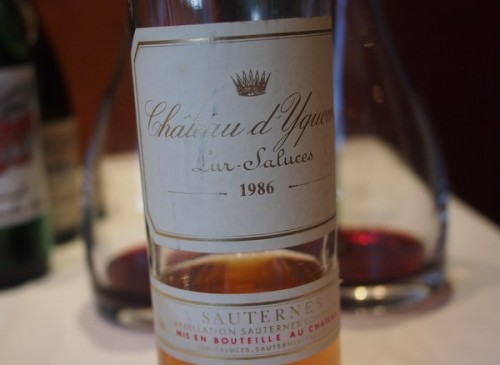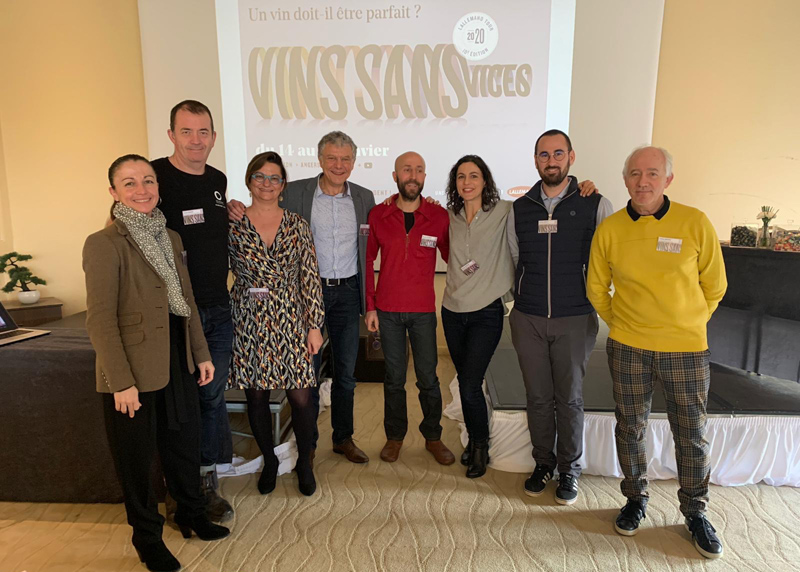
There’s a well known phenomenon in the world of wine that so far has been unexplained. It’s the way that as sweet wines age, they taste less sweet. If you get a 30 year old Sauternes, it isn’t nearly as sweet tasting as a younger wine, even if both started out with the same level of sugar to start with. This dissapearing sweetness is described as the wine ‘eating sugar’.
So what could be happening? I don’t know of any studies that have tracked the actual sugar level in a particular wine over time, to see whether the sugar is in some way disappearing. It could be that there is an as-yet undiscovered reaction taking place consuming the sugar. But I don’t think this is what is happening here.
I have an alternative explanation: the effect of volatile compounds on the perception of sweetness. It’s well known already that when we taste a wine, its sweetness or dryness isn’t just dependent on the level of sugar. Acidity has an important role to play. Champagnes with 10 g/litre of sugar and 10 g/litre of acidity taste bone dry. Put that level of sugar into a wine with less acidity and it will taste quite sweet.
So it should come as no surprise that the smells we detect when we taste a wine will influence how sweet we find that wine. In particular, fruity aromas enhance the perception of sweetness. We can’t smell sweetness, but fruity aromas smell sweet. Why? Because we have learned to associate them with sweetness.
A young Sauternes, for example, usually has very high levels of fruity aromas, typically apricot, passionfruit and peach. These in part come from volatile thiols such as 3MH and 3MHA: botrytised wines usually have sky high levels of these. With time in bottle, these fruity aromas diminish. Smell an old Sauternes: it smells much less fruity than a young one, and usually has complex savoury aromas that have developed with time. It isn’t surprising, therefore, that if the wine smells less sweet, it should also taste less sweet.
The brain is computing the sensation of sweetness not only from the sugar level, but also from the smell of the wine. Even if the old wine still has the same level of sugar, the perception we have of its sweetness has changed.
Support for this idea comes from a couple of recent studies on tomatoes and strawberries, carried out by Linda Bartoshuk and her colleagues at Florida University. They looked at the composition of a range of tomato varieties, testing the levels of sugar and also a group of volatile compounds. They then got a sensory panel to taste these tomatoes, rating them for a range of attributes, including sweetness. They then looked at which compounds contributed to this perception of sweetness: it turned out not to not only be sugar, but also a group of seven volatiles.
For example, one variety had 45 g/l of sugar and was given a score of 13 on the perceived sweetness scale, while another had less sugar (just under 40 g/litre) but got a score of 25. It got this big score because it had about twice the level of a group of six volatiles that were correlated strongly with sweetness.
In the strawberry work, the researchers found 24 volatile compounds that showed significant correlations with perceived sweetness intensity, independent of glucose or fructose levels, and 20 that did this independent of sucrose concentration. Of these, six altered sweetness perception independent of all three sugars.
What is happening here? There are two ways in which we smell something. The first is through the nose, and it’s called orthonasal olfaction. The second is by aromas entering the nose round the back, from the mouth, which is called retronasal olfaction. The brain deals with these two types of smell differently. ‘Taste’ is computed from the taste sensations plus the retronasal olfaction, which are processed together. Sweet smells are likely to result from previous pairings of volatiles and sweet tastes, such as the smell of strawberries, peaches, vanilla and caramel.
So, as a sweet wine ages its smell changes. And even if the sugar level stays the same, the perception of sweetness will change. It’s likely that this is the explanation for wines that ‘eat sugar’ as they age, although I can’t rule out the possibility that sugar levels are also declining in some mysterious way through chemical reactions.
10 Comments on ‘Eating sugar’: why old sweet wines often taste drier

If smell makes the wine taste less sweet it is very easy to check. Just taste the wine by holding your nose. If it taste less sweet when you let go of your nose your theory is proven right.
I’ve learny that the sugars in wine creates longer chaims of carbohydrates during ageing and that is why they taste less sweet.
Anders – alas that wouldn’t work. Holding your nose doesn’t stop you smelling. You still have the retronasal olfaction even when your nose is held, and this is the one that the brain combines with taste sensations to produce taste.
But it is possible, as I point out, that the sugars are chemically modified during the ageing process. I’ve never seen data on this
Thanks Jamie, very interesting.
I strongly suspect that the answer lies in both the changes in aromatics as well as some changes in the actual sugars. I’d love to see some research emerge in this area. The apparent changes in acidity would also be interesting to study. When does acidity (eg in dry riesling and champagne) seem to soften over time? Perhaps again there may be a number of effects, such as changes in aromatics and changes in the actual acidity.
It seems very unlikely to me that this phenomenon can be the result of polymerization of monosaccharides, as Anders suggests the literature says. I am intrigued by the idea that it is the result of changes in the wine’s aromatic profile. But with Riesling, fresh fruit aromas often give way to toast and honey aromas over time, the latter of which should trigger some kind of connection in the brain with sweetness.
It is indeed puzzling that no one seems to have actually measured the sugar content of wines as they age. My hunch is that they stay the same, aside from a small amount that becomes oxidized.
Way beyond my depth here, but my recollection from reading Margalit is that polyalcohols (eg. glycerol) typically found in late-harvest, amarones, etc. are responsible for some of the sweetness component. It is possible that these complex alcohols break down into simpler forms over time, thereby giving up some of their sweetness characteristics?
(Last sentence was intended to be phrased as a question.)
Love your science posts.
Jamie and Anders
Whether holding your nose works or not in stopping retronasal olfaction is an interesting one. Gordon Shepherd in his book Neurogastronomy (p28) says it does, and you would think he should know. He says you need to be able to breathe out for retronasal olfaction.
However, the last time I tried it with wine I was not convinced. I thought maybe it dulled flavours, but they were still there. I must try again sometime soon, perhaps with different flavoured sweets, as they are easier to control than wine, and have more obviously different aromas.
* Please note that Linda Bartoshuk is with the University of Florida, not Florida University. Just a little note, and now please carry on.
Late catching up with this but tanks Jamie for tackling the issue and calling our attention to the surprising and frustrating lack of evidence that any research has been done to explain the phenomenon in question.
I am skeptical that Jamie’s hypothesis can entirely explain this phenomenon but I am confident that such factors as he adduces from outside the realm of whatever might be happening to sugar molecules themselves are at least contributory. I feel pretty confident, at least in the area of German Riesling, in my ability to judge the approximate level of residual sugar in a young wine, recognizing that sweetness in that genre may be barely noticeable as sweetness even when one is tasting a wine with as much as 20 grams of residual sugar. Once a German Riesling has aged for a decade or more, I find myself quite INcapable of judging whatever amount of residual sugar it might have begun life, and I don’t know whether I could with any accuracy guess what it has left in it since none of us apparently even know whether the level of sugar decreases to any significant degree with time!
Working up from the bottom of the comments, Gordon Shepherd’s view on blocking retronasal olfaction is definitely received opinion among those with whom I have discussed matters related to wine tasting or shared presentations, such as members in the Network for Sensory Research. My own experience has been that blocking is almost complete, and I am not sure whether the extent to which it seems not quite complete is a matter of taste physiology or imaginative projection.
In the matter of how acidity changes as a wine ages, there is considerable literature. See for example the following papers:
http://m.ajevonline.org/content/36/2/118.abstract
http://www.ncbi.nlm.nih.gov/pubmed/15853394
As to the suggestion that it is “very unlikely … that this phenomenon can be the result of polymerization of monosaccharides,” chemist friends have shared that same opinion with me. Received opinion at Geisenheim (based on course handouts that have been shared with me; sorry that I do not have links to any original research) suggest the following mechanisms:
caramelization
polymerization
production of furfural from fructose.
Reactions I have been able to attract from friendly wine-interested chemists in several countries have been highly skeptical of this trio. Certainly there is caramelization, but for it to significantly enough influence a wine’s sugar chemistry, the suggestion has been that it would result in much greater darkening of the wine than we actually perceive (even allowing for oxidation). Response to the other hypotheses has been that at cellar temperatures the relevant reactions would be far too slow to transform sugars to an extent consistent with observable diminution of sweetness. But, PERHAPS some combination of the above mechanisms PLUS the factors that Jamie adduces could be sufficient to get us there.
As if all this were not frustrating enough, one of my chemist friends wrote me a few years back that “someone with an LC/mass spec could settle [a lot of these issues] pretty rapidly, and I suspect someone has.” Yet, evidence of that someone has yet to turn up!
Hopefully some more chemists can respond to this thread.